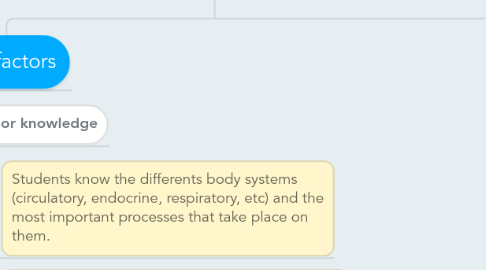
1. Standard: Plan and conduct an investigation t provide evidence that feedback mechanisms maintain homeostasis.
2. Grade level: 11 Grade
3. Subject: Biology
4. Key factors
4.1. Prior knowledge
4.1.1. Students know the differents body systems (circulatory, endocrine, respiratory, etc) and the most important processes that take place on them.
4.1.2. Computer skills are high due to the school policy ( students need to bring their own laptop for academic purposes all days)
4.2. Readiness level
4.2.1. 75% of students are not English native speakers, but only 10-15% are consider as a ELL students.
4.2.2. 4% of students are LS students (per each grade level)
4.3. Reason for scaffolding strategies
4.3.1. Cue cards: Students will learn the new vocabulary by making a glossary. ELL and LS students will have in a organized way all the main concepts they have to learn to meet the standards.
4.3.2. Question stems: Students will learn how to use the new concepts and vocabulary in context. This strategy will be very usefull for ELL and LS students. This activity can be offered in three different levels: low, medium or high and give students the option to choose what they want to do (students will earn points that can be exchanged in the final test with an optional question to get a higer score, this system will be use in several activities, so students do not need to use the high option for all of the unit activities)
4.3.3. Flow charts: Visual and auditory students will review/learn how the differents homeostatic processes take place by connecting key concepts in a chart.
4.3.4. Mind maps: Students will learn or review the homeostatic processes "by doing". Producing mind maps will be benefitial for kynesthetic learners, ELL and LS. High prep students can produce a more detailed ones.
4.3.5. Question cards: This strategy will help students to mentally review their knowledge about the unit and connect all the information explained during the lesson. This type of activity can show the purpose or the real importance of the processes to the students that need to see what they are learning applied into real life.
4.3.6. Examples: Students will have the opportunity to see the final work that the teacher expects from them. They can analyze and see what aspects have to be taken in consideration. This activity can be combined with "carrussel feedback" strategy for a higher student's involvement.
4.3.7. Explanation: Introducing a new topic need some guided directions from the teacher. This activity will be benefitial for audiology learners as well as for ELL students.
4.3.8. Advanced organizers: Rubrics or checklist can decrease student's doubts or even anxiety. If they know what is expected from them they can organized themselves better. ELL and LS students have clear instructions of what they need to do, so ELL or LS assistant know the directions to help them with their work.
5. Objectives
5.1. Objective 1: Master concepts related with this such as a definition of homeostasis, positive and negative feedback, etc.
5.1.1. Scafolding strategies
5.1.1.1. Cue cards: Students will use flashcards for learning new vocabulary and definition of the concepts
5.1.1.2. Question stems: Students will complete sentenes using the new concepts and vocabulary for this unit.
5.2. Objective 2: How variations affect to the maintenance of homeostasis.
5.2.1. Scaffolding strategies
5.2.1.1. Flow charts to illustrate the different processes and reactions.
5.2.1.2. Mind maps: Students will create their own mind map connecting the different processes that occur for maintaining the homeostasis.
5.2.1.3. Question cards: Students will have different real cases and come up with a explanation after the main lesson
5.3. Objective 3: Analyze a scientific poster
5.3.1. Scaffolding strategies
5.3.1.1. Explanations: Teacher will explain all the prompts that shoul be covered on a poster. Students will have a checklist and analyze some scientific poster to familiarized with them.
5.3.1.2. Examples: Students will have access to several scintific posters
5.4. Objective 4: Produce a poster about their own experiment
5.4.1. Scaffolding strategies
5.4.1.1. Question cards: Students will have some crds with questions that should be covered to design their experiment
5.4.1.2. Examples: Students will have real scientific poster in the classroom to guided the production of their posters
5.4.1.3. Advance organizers: Students will have the rubric of the project, so they can know what is expected for them (experiment and poster)
6. Big ideas
6.1. To meet the standard the students will be able to:
6.1.1. Understand what homeostasis means, the importance of this process and the different types of regulation we can find in the human body.
6.1.2. Connect ideas; know the processes identify the causes that lead those changes and how you can observe them
6.1.3. Read and analyse scientific texts.
6.1.4. Develop critical thinking skills to design and analyze the experiment
6.1.5. Produce scientific writing and develop computational skills to create their poster
